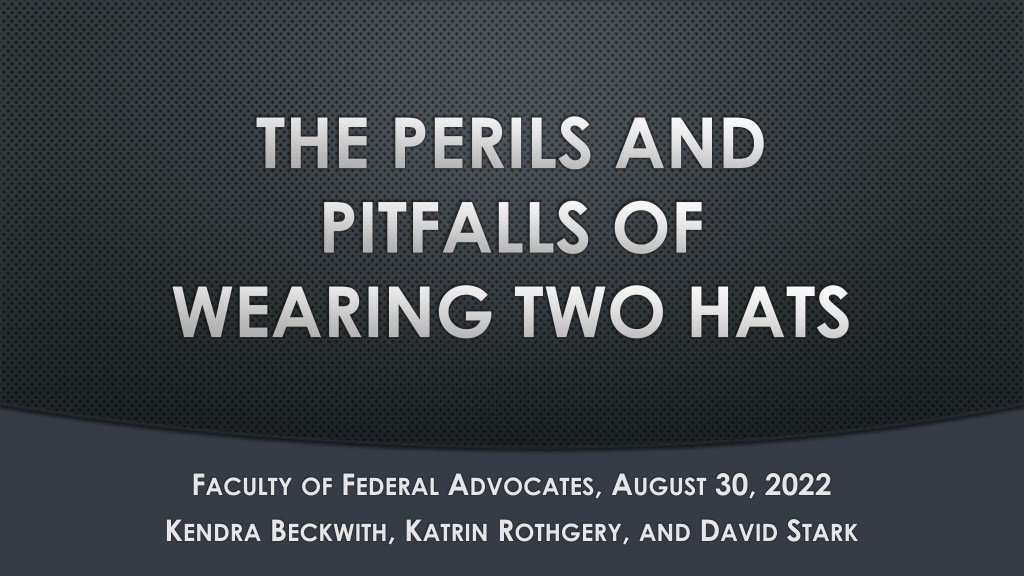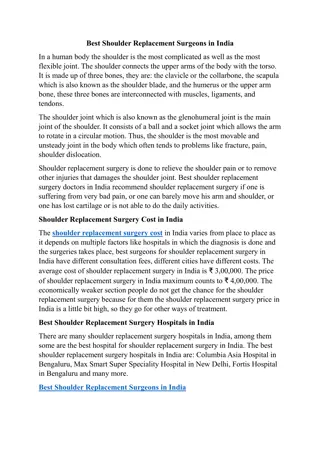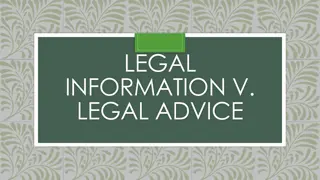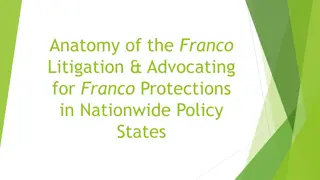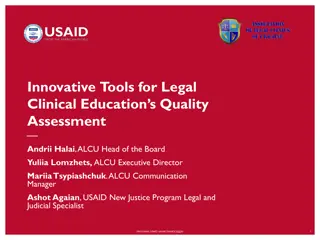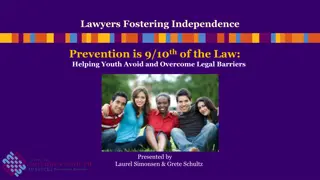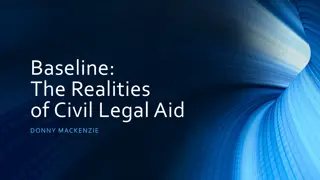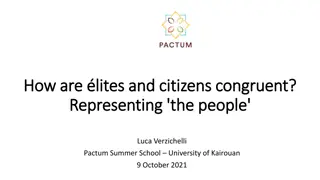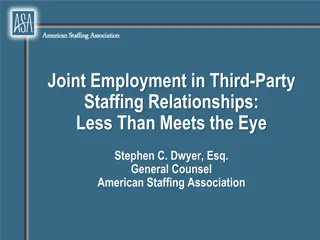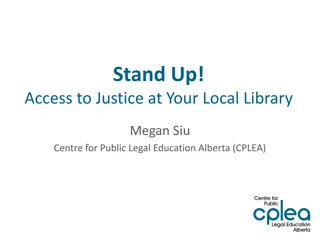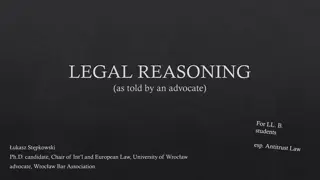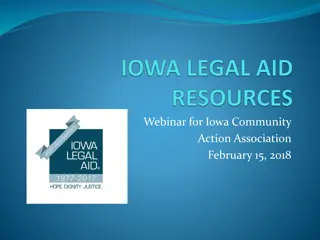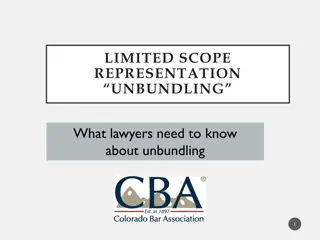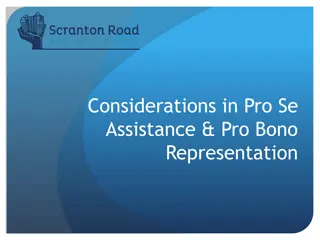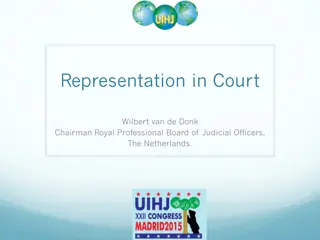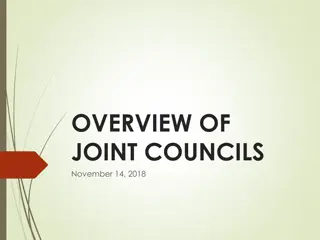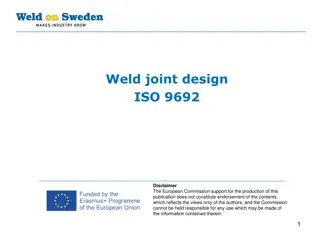Navigating Joint Representation in Legal Practice
Exploring the complexities of joint representation in legal practice, this content delves into the perils and pitfalls of wearing two hats as counsel for multiple clients. It discusses the necessity and challenges of engaging in joint representation, conflicts of interest, and the rules governing concurrent conflicts. Additionally, it examines direct conflicts, material limitations, fee arrangements, and the risks associated with sharing confidential information, providing valuable insights for legal professionals.
Download Presentation

Please find below an Image/Link to download the presentation.
The content on the website is provided AS IS for your information and personal use only. It may not be sold, licensed, or shared on other websites without obtaining consent from the author. Download presentation by click this link. If you encounter any issues during the download, it is possible that the publisher has removed the file from their server.
E N D
Presentation Transcript
THE PERILS AND PITFALLS OF WEARING TWO HATS FACULTY OF FEDERAL ADVOCATES, AUGUST 30, 2022 KENDRA BECKWITH, KATRIN ROTHGERY, AND DAVID STARK
JOINT REPRESENTATION What is necessary to jointly engage two clients? Can you engage in a joint representation (and should you)? What happens when a conflict arises?
Can you engage in a joint representation (and should you)?
RULE 1.7 (CONCURRENT CONFLICTS) General Rule (Rule 1.7(a)) Lawyer may not represent a client if the representation involves a concurrent conflict of interest Directly adverse Materially limited Exception (Rule 1.7(b)) Reasonably believe you can provide competent and diligent representation Not prohibited by law Does not involve assertion of a claim by one client against another client in the same proceeding EACH affected client provides informed consent, confirmed in writing
WHAT DOES THAT MEAN? Direct conflict One in which the multiple clients interests are directly adverse Transactional context Relationship is not hostile, but can still be adverse Litigation context Facts of the case, testimony discrepancies, incompatible positions as to opposing party, substantially different settlement possibilities
WHAT DOES THAT MEAN? Material limitation There is a significant risk that the representation of a jointly represented client will be materially limited by the lawyer s responsibility to another client or by the lawyer s own interests Whether ability to recommend or advocate all positions that each client might reasonably take will be limited because of duty of loyalty to the other client Long-standing relationship with client Monetary arrangements
Fee arrangements One client paying both fees Long-standing relationship with one client Can you be non-partial Sophistication Will the clients understand the sharing of confidential information under Colo. RPC 1.6? What s the risk a future conflict will develop?
COMPETENCE DILIGENCE INFORMED CONSENT
JUST BECAUSE YOU CAN DOESNT MEAN YOU SHOULD Some other method? Joint defense agreement Payment of fees for second counsel Fallibility of Informed consent Prospective waivers
CBA ETHICS COMMITTEE OPINIONS Formal Op. 135: Ethical Considerations in the Joint Representation of Clients in the Same Matter or Proceeding More litigation driven Formal. Op. 68: Conflicts of Interest: Propriety of Multiple Representation Great examples for family and transactional law Note: Formal Op. 57, Conflicts of Interest is superseded. Ethics Opinions are advisory, not binding.
What is necessary to jointly engage two clients?
DISCLOSE, DISCLOSE, DISCLOSE Informed Consent starts with information Rule 1.7 cmt [18]: Informed consent requires that each affected client be aware of the relevant circumstances and of the material and reasonably foreseeable ways that the conflict could have adverse effects on the interests of that client. Lawyer s job to provide
WHAT ARE THE RELEVANT CIRCUMSTANCES? Does the lawyer have a long-standing relationship with one client, while the other is new? Is one client paying the bills, creating the appearance of an imbalance of power? Is one client empowered to speak for the group?
SAMPLE LANGUAGE: PRIOR RELATIONSHIP As you are aware, FIRM represents and has represented previously CLIENT ONE in a variety of legal matters. In deciding whether or not to engage FIRM to represent you jointly in this matter, as described in more detail below, you should consider whether you believe FIRM will be less zealous or eager on your behalf because of its prior relationship with CLIENT ONE; whether FIRM S exercise of its professional judgment could be affected by its prior representation of CLIENT ONE; or whether FIRM S acquisition of confidential information about each of you as it concerns this engagement could be detrimental to you based on FIRM s prior representation of CLIENT ONE. To be clear, we do not believe that our representation of you, jointly, in this matter will be limited in any way by our prior representation of CLIENT ONE. But these are important issues you should consider as you make decisions about joint representation.
WHAT ARE THE POSSIBLE ADVERSE EFFECTS? Rule 1.7 cmt [18]: When representation of multiple clients in a single matter is undertaken, the information must include the implications of the common representation, including possible effects on loyalty, confidentiality and the attorney-client privilege and the advantages and risks involved. See also cmts [29] [33]
SAMPLE LANGUAGE: CONFIDENTIALITY AND PRIVILEGE In a joint representation such as this one, there is no confidentiality between you with regard to information material to the representation. In other words, what one client shares with the lawyers working on the Transaction might be shared with the other clients, because all of you, jointly, have a general right to know what information your lawyers possess, and to understand the advice we have given. In a joint representation, no client can claim that information provided to the lawyers should be kept confidential from other joint clients. The lack of confidentiality as between each of you means that if you later engage in litigation against each other, none of you will be able to claim a privilege as to communications between any of you and FIRM concerning this matter. If you are concerned about maintaining the confidentiality of your information as to the other joint clients identified in this letter, then you should consider arranging for separate counsel. Conversely, if you are not concerned about this issue, then our joint representation of you should enable you to work together efficiently and effectively to complete the Transaction. You should also note that the joint representation does not compromise in any way the attorney-client privilege as to any third party.
SAMPLE LANGUAGE: HOW MIGHT A CONFLICT ARISE? In our judgment, at this time there is no conflict of interest between you. This conclusion is based on the fact that you share common interests in this matter, in that you all have the same goals of successfully defending or settling the litigation on terms that are favorable to you all, collectively. However, as separate entities with different financial and personal motivations, your interests might, at some point, diverge. For example, a dispute could arise between some or all of you with regard to the terms of a settlement, including the total settlement amount or the details of how the settlement will be funded. These are just some examples of conflicts that could arise. To help us continue to assess conflicts, we will depend on you to keep us advised of changes in owners, principals, affiliates and potential adverse parties that might affect our analysis of actual or potential conflict of interests. We will also depend on you to keep us apprised of any divergence in your respective expectations, strategies, or goals with regard to our work in the litigation.
SAMPLE LANGUAGE: CONFLICT RESOLUTION If a conflict of interest arises between you, you understand and agree that FIRM will first provide the parties with an opportunity to resolve such conflict of interest and, if such conflict of interest cannot be resolved, then FIRM will be required to withdraw from the representation of all of you in this matter and will not represent any of you against the others with regard to this litigation or any subsequent matters that arise from it. Such withdrawal could result in additional costs to you, inconvenience, delay in assertion of your rights by having new counsel become familiar with the facts and issues involved, and compromise of confidential information that you shared with us during the pendency of our representation.
FINAL DETAILS Requirement: Put it in writing Best Practice: Ask for client signature
What Happens When a Conflict Arises?
HOW DOES IT HAPPEN? ONE CLIENT WITHDRAWS CONSENT ONE CLIENT WANTS YOU TO WITHHOLD INFORMATION FROM THE OTHER LAWYER IS AWARE OF INFORMATION HARMFUL TO OTHER CLIENT S INTERESTS ONE CLIENT OFFERED A PLEA BARGAIN IN EXCHANGE FOR TESTIMONY LIMITED RESOURCES TO SATISFY A JUDGMENT LUMP SUM SETTLEMENT OFFERED CLAIMS BY ONE CLIENT AGAINST ANOTHER ALLOCATION OF FAULT BETWEEN PLAINTIFFS OR DEFENDANTS
WHAT TO DO AGGREGATE SETTLEMENT OFFER-RULE 1.8 (G) MUST HAVE INFORMED CONSENT BY EACH CLIENT IN A WRITING SIGNED BY EACH CLIENT EVALUATE ON AN ONGOING BASIS WHETHER DEVELOPMENTS REQUIRE ADDITIONAL DISCLOSURES AND CONSENTS RULE 1.4 (A) (1) CONSIDER WHETHER WITHDRAWAL IS REQUIRED FROM ALL CLIENTS-RULE 1.7 CMT. 29 CONSIDER RULE 1.9 IF ONE CLIENT WITHDRAWS CONSENT FORMER CLIENT CANNOT REPRESENT ANOTHER IN SAME OR SUBSTANTIALLY RELATED MATTER- RULE I.9 (A) CANNOT USE OR REVEAL INFORMATION TO DISADVANTAGE OF FORMER CLIENT-RULE 1.9 (C)
POSSIBLE FALLOUT WITHDRAWAL REQUIRED FROM ALL CLIENTS ADDED COSTS TO CLIENT DELAYS EMBARRASSMENT NON-PAYMENT GRIEVANCES FIRED CLAIMS AGAINST YOU AND/OR THE FIRM
HOW TO HANDLE FALLOUT DO NOT TRY TO HANDLE IT YOURSELF!! USE YOUR RESOURCES YOUR FIRM ETHICS COUNSEL OR GENERAL COUNSEL YOUR MENTOR FIRM S INSURANCE CARRIER OUTSIDE COUNSEL CBA ETHICS HOTLINE-303-860-1115 ETHICS OPINIONS-CBA 135 AND ABA 08-450 BEWARE OF WAIVING PRIVILEGE FOR YOUR COMMUNICATIONS
